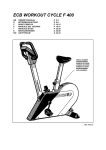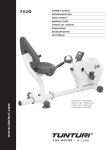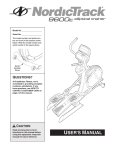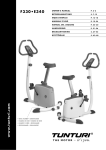Download Assembly Instructions
Transcript
Electrically Assisted Pedal Cycles Assembly Instructions Version 5 – 19 Dec 2005 Introduction Thank you for buying a PowaCycle Cambridge/Oxford electric bike. We hope it brings you many hours of enjoyment. For safe and compact shipping, we have despatched your PowaCycle Cambridge/Oxford part assembled. It therefore requires some assembly work before you can begin riding. Please follow these instructions carefully. If you do not feel confident to assemble the bike yourself, we recommend you visit your local cycle store for professional help and advice. Some assembly details may vary due to the recent product improvements. Contents Before assembly, please check that you have all the parts below: Front Wheel Battery Charger Pedals 2 x Nut covers for front forks Main Cycle Frame 2 Assembly Instructions Charge the Battery Before assembling your PowaCycle, you should charge the battery. This will allow you to test the electrical connections during assembly. It may take up to 6 hours to fully charge the battery. When charged, the LED turns from red to green. Please note, the battery will deteriorate if it is left uncharged. A lever at the base of the saddle column releases the saddle, allowing the saddle to be lifted out of the bike frame, this makes the battery accessible. Lift the handle on the battery and Slide the battery from the base housing. You will notice 2 pieces of plastic covering the contact terminals, remove these from the bike. Charge the battery away from water or combustible material. Connect the roundended charger plug to the battery socket. Plug the charger into the mains supply and switch it on at the plug. 3 Fitting the Handlebars The handlebars are already attached to the frame via cables. They now need to be inserted into the frame as shown. Align the handlebars 90 degrees to the forks. Finally, use an Allen key supplied or hexagonal tool to tighten the handlebars in place. NOTE: We recommend that you make a final adjustment of the handlebars once the bike is fully assembled. 4 Fitting the Wheel Remove the black plastic front fork protectors, which are part of the protective packing material. We recommend that you turn the bicycle upside down, resting it on the handlebars and saddle. Note: We suggest you remove the battery, to make the bike lighter, before turning it upside down. Also, you may need to adjust the saddle to make it more stable. Place the wheel between the forks. Then fasten the nuts and washers to each side of the wheel spindle, tightening them evenly. Use a spanner supplied to secure the nuts firmly to the forks. The wheel needs to spin freely, so avoid over tightening. 5 Brake Assembly With the cycle upside down, ensure that the brake blocks have clearance from, and are parallel to the wheel rims. Use an Allen key or hexagonal tool to adjust and secure the blocks Place the brake cable in the brass fitting (arrowed). On the opposite side of the wheel, a nut is fixed to the brake mechanism, holding the wire cable. Loosen this nut to allow you to pull the cable through and take up any slack. Then retighten the nut. Check that the wheel spins freely and the brake operates effectively when applied. Fine adjustments to the brake tensions can be made via adjustment controls located at the junction of the brake lever and cable. Fitting the Pedals Pedals are marked L and R, for the left and right hand side of the bicycle when it is facing forward. Screw each pedal into the appropriate pedal shaft by hand, and then tighten with a spanner to secure. The pedals have a reverse thread and therefore need to be screwed in backwards. 6 Completed PowaCycle Cambridge/Oxford Finally … Before mounting your cycle to ride, remember to check that: · · · · · · · the battery is fully charged. the tyres are inflated to the correct pressure. the brakes are operating effectively. the handlebars are correctly adjusted and secure the seat is at the correct height for the user the lights are working all nuts and bolts are secure (including preassembled ones). 7 Operation of the Cambridge/Oxford PowaCycle Overview The PowaCycle Cambridge/Oxford is an electrically assisted bicycle that operates as a standard bicycle, with the assistance of a motor and battery. The power provided supports the rider’s own efforts, giving increased performance with less effort. Battery Charging, Care & Safety Care of the battery is vital to maximise its longterm performance. · The battery must be removed from the bike for charging. · Regular Use – If you are commuting significant distances, it is advisable to recharge the battery before the return journey. · Occasional Use – Recharge the battery at least once a week, even if the cycle is unused. · Always recharge the battery after use. · Always charge the battery indoors. · Keep the battery away from water, to prevent shocks or shorting. When attached to the bicycle, it is safe to operate in wet conditions. · Do not cover the battery or charger. · Do not leave the battery permanently charging from the mains supply. · Only use the charger provided to charge the battery. · Do not use the battery to power anything other than the PowaCycle for which it was purchased. · Do not disassemble or modify the battery. · Do not expose the battery to fire or extreme temperatures. · Do not short circuit the battery. · Do not allow impact or force against the battery pack. · Dispose of the battery in a dedicated waste facility. 8 Additional Lights As an additional safety feature, we recommend that night users purchase independent front and rear lights that are NOT powered from the cycle battery. After a long journey, there is a risk that the cycle battery could be depleted, so lights relying on the cycle battery could stop working. Tyres · Check the tyres regularly to ensure that the correct pressures are maintained (pressure ranges are shown on the sides of the tyres). · Do not overinflate the tyres. · There are different types of pumps available for cycles. Ask your local cycle shop for the one best suited to your needs (do not use a garage forecourt air hose to inflate your tyres). Brakes · Make sure your brakes are adjusted correctly at all times. · Adjustment can be made at the wheel rim/brake mechanism with tools. Fine tuning of the brakes can be made via adjustable twist screws that are located at the join of the brake lever to the cable. · Replace the brake blocks when worn. Power Switch on the power by pressing the switch on the battery. The Cambridge/Oxford can be operated as a “pedelec”. This means that, as soon as the rider begins to pedal, the motor supplies energy to support the cyclist’s efforts. If the rider prefers to cycle without the assistance of the motor, he or she should turn the power off. Throttle In order to use the throttle power, the red button on the handle bar must be pressed (this activates the throttle) and then the throttle (located on the right handle bar) can be used. 9 Gears and Bicycle Chain Change through the gears one at a time and only when the bicycle is being pedalled. To maintain performance, ensure that all the mechanical parts of the gears are lightly oiled (avoid getting oil deposits on the wheel rims). If the chain mechanism becomes dislodged, turn the pedals forward gently to engage it. If the chain becomes completely dislodged, reengage it on the smallest gear cog. Saddle For maximum comfort ensure that the saddle is both correctly adjusted and secure. Once set up correctly, the height of the saddle can be adjusted without tools. Loosen the lever at the top of the frame below the saddle to raise or lower the saddle. Once the saddle is at the required height, secure it by tightening the lever. Tighten or loosen the nut on the lever if required. User Safety Cycle Helmets Although there is no legal requirement to wear a cycle helmet, we recommend that you do so for your safety. Wearing a cycle helmet has been proven to reduce the likelihood of head injuries. Professional Maintenance We recommend you have your cycle serviced by a professional cycle engineer at least once a year to ensure ongoing safe performance. If you are unsure as to how to carry out an assembly procedure or adjustment, we recommend that you consult your local cycle shop. Troubleshooting 1 – Brakes not working effectively Check the distance between the brake blocks and the wheel rim. Check that the blocks are parallel with the wheel rim. Check for any wear on the brake blocks Fine tuning to the brakes can be performed by the adjusters between the brake lever on the handlebars and the brake cable. Major adjustments are made at the brake blocks and you will need the appropriate tools. See brake assembly instructions. 10 2 – Motor not working Check that the ignition has been switched on Check that the battery is properly inserted in its housing. Check that the battery is charged. Check that none of the electrical cables and connections has become dislodged. 3 – Light(s) not working Check that the wiring is not broken. Check that the bulbs are inserted correctly. Check that all connections are made properly Warranty Information 1 – The frame – Has a warranty of two years. 2 – Other main parts – Have a warranty of one year. 3 – The battery – Is covered by a 6 month warranty, as battery life will be determined by user care. 4 – Bulbs, brake blocks, tyres etc – Are regarded as consumables, therefore when replacements are required, these need to be purchased from your local cycle shop or store. PowaCycle, Ultima Networks PLC, Akhter House, Perry Road, Harlow, Essex, CM18 7PN Tel: 01279821243 www.PowaCycle.co.uk Version 3 – 8 Sept 2005 11




















